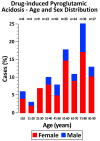Drug-Related Pyroglutamic Acidosis: Systematic Literature Review
- PMID: 39407841
- PMCID: PMC11476987
- DOI: 10.3390/jcm13195781
Drug-Related Pyroglutamic Acidosis: Systematic Literature Review
Abstract
Background: Inborn errors of glutathione metabolism may cause high anion gap metabolic acidosis due to pyroglutamic acid accumulation. Since 1988, cases of this acidosis have been reported in individuals without these defects. Methods: Given the poorly characterized predisposing factors, presentation, management, and prognosis of acquired pyroglutamic acidosis, we conducted a systematic review using the National Library of Medicine, Excerpta Medica, Web of Science, and Google Scholar databases. Results: A total of 131 cases were found. Most patients were females (79%), adults (92%) aged 51 years or older (66%) with pre-existing conditions (74%) such as undernutrition, alcohol-use disorder, or kidney disease, and had an ongoing infection (69%). The clinical features included diminished consciousness (60%), Kussmaul breathing (56%), and nausea or vomiting (27%). At least 92% of patients were on paracetamol therapy for >10 days at an appropriate dose, 32% on a β-lactamase-resistant penicillin, and 2.3% on vigabatrin. Besides severe anion gap acidosis, patients also presented with hypokalemia (24%) and kidney function deterioration (41%). Management involved discontinuing the offending drug (100%), bicarbonate (63%), acetylcysteine (42%), and acute kidney replacement therapy (18%). The fatality rate was 18%, which was higher without acetylcysteine (24%) compared to with it (11%). Conclusions: Acquired pyroglutamic acidosis is a rare, potentially fatal metabolic derangement, which usually occurs after paracetamol use, frequently combined with a β-lactamase-resistant penicillin or vigabatrin. This condition predominantly affects adults, especially women with factors like undernutrition, alcohol-use disorder, or kidney disease, often during infection. Increased awareness of this rare condition is necessary.
Keywords: 5-oxoproline; acetaminophen; acid base equilibrium; drug-related side effect; vigabatrin; β-lactamase-resistant penicillin.
Conflict of interest statement
The authors declare no conflicts of interest.
Figures



References
Grants and funding
LinkOut - more resources
Full Text Sources
Miscellaneous

